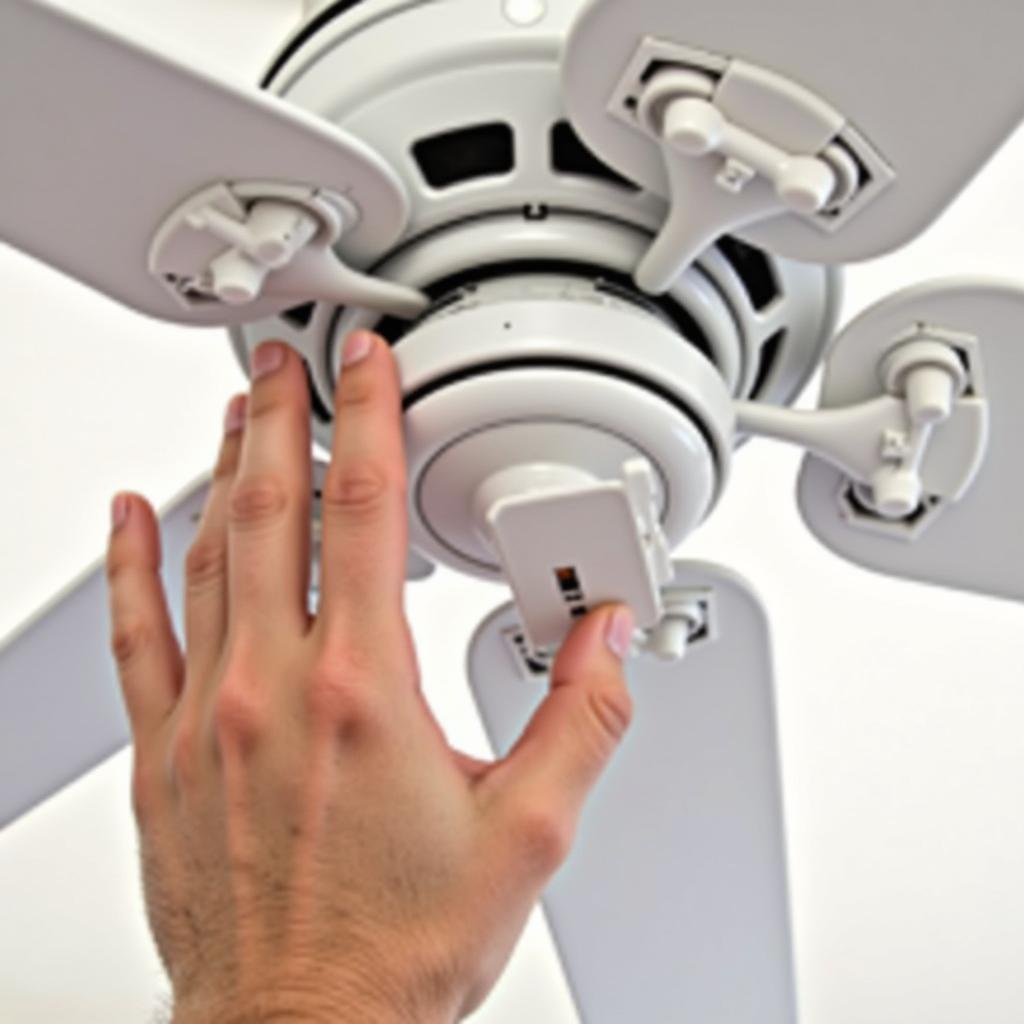Knowing the right ceiling fan direction for summer can make all the difference in staying cool and comfortable during those hot months. While it seems simple, many people are unsure which way their fan should rotate for optimal airflow and energy efficiency. This guide will dive deep into the science behind ceiling fan direction, bust common myths, and provide practical tips to maximize your fan’s cooling power this summer.
 Ceiling Fan Rotating Counterclockwise in Summer
Ceiling Fan Rotating Counterclockwise in Summer
Understanding the Physics of Airflow
Before we delve into the ideal ceiling fan direction for summer, it’s crucial to grasp the basic principles governing airflow. When your ceiling fan spins in a specific direction, it creates an airflow pattern known as updraft or downdraft.
- Downdraft: This is the desired setting for summer. When your fan blades rotate counterclockwise, they push air downwards, creating a direct cooling breeze that you can feel. This wind chill effect makes you feel cooler, even if the room’s temperature remains the same.
- Updraft: This setting is used during winter to circulate warm air. When your fan blades rotate clockwise, they draw cooler air upwards, pushing the warmer air near the ceiling downwards. This helps even out the temperature throughout the room, making it feel warmer.
Ceiling Fan Direction Summer: Counterclockwise is Key
For optimal cooling during the summer months, ensure your ceiling fan rotates counterclockwise. This creates that refreshing downdraft, pushing cool air directly down into your living space. You’ll immediately notice the difference as the circulating air creates a “wind chill” effect on your skin, making you feel cooler even without lowering the thermostat.
 Close-up of Hand Flipping Ceiling Fan Switch
Close-up of Hand Flipping Ceiling Fan Switch
Finding the Right Fan Speed for Summer
While the counterclockwise direction is crucial, finding the optimal fan speed is equally important for maximizing cooling comfort.
- Low to Medium Speed: For a gentle breeze, especially in the evenings or mornings when the heat isn’t as intense, a lower fan speed is ideal.
- High Speed: During the hottest parts of the day, crank up your fan to a higher speed to create a stronger downdraft. This will provide a more noticeable wind chill effect, making you feel cooler faster.
Experiment with different speeds to find the perfect balance between comfort and cooling power for your needs.
Common Myths About Ceiling Fans Debunked
There are several misconceptions surrounding ceiling fans and their effectiveness in summer. Let’s debunk some of these myths:
- Myth: Ceiling fans cool the room.
- Fact: Ceiling fans don’t actually lower the temperature. They simply create a wind chill effect by circulating air, making you feel cooler.
- Myth: Leaving the ceiling fan on when you leave the room keeps it cool.
- Fact: As mentioned, fans don’t impact the room’s temperature; they affect how we perceive it. Leaving it on when you’re not present wastes energy.
Maximizing Your Ceiling Fan’s Efficiency
Here are some additional tips to optimize your ceiling fan’s performance this summer:
- Clean Your Fan Blades Regularly: Dust accumulation can hinder your fan’s efficiency. Wipe down the blades regularly to ensure optimal airflow.
- Check for Wobbling: A wobbly fan indicates an imbalance, reducing its effectiveness and potentially causing noise. Tighten any loose screws or consult a professional if needed.
- Consider Fan Size and Placement: Ensure your ceiling fan is appropriately sized for the room. A fan that’s too small won’t circulate air effectively, while one that’s too large might consume excessive energy.
Conclusion: Stay Cool and Comfortable All Summer Long
By understanding the simple principle of ceiling fan direction in summer, you can significantly enhance your comfort and beat the heat. Remember, counterclockwise rotation is key to creating a refreshing downdraft. Pair this knowledge with smart fan usage and maintenance, and you’ll enjoy a cool and comfortable home all summer long.
FAQ
1. Does ceiling fan direction matter in winter?
Yes, reversing your ceiling fan direction to clockwise during the winter helps circulate warm air more evenly, improving your heating system’s efficiency.
2. How do I know if my ceiling fan is spinning counterclockwise?
Stand directly under the fan and observe the blades’ rotation. If they’re moving to the left, it’s counterclockwise, ideal for summer.
3. Can I leave my ceiling fan on all the time in summer?
While it’s tempting, leaving your ceiling fan running constantly isn’t necessary and wastes energy. Only use it when you’re in the room to benefit from the cooling effect.
4. How often should I clean my ceiling fan blades?
Cleaning your fan blades every few weeks during the summer is recommended, especially if you live in a dusty environment.
5. What if my ceiling fan is making a clicking noise?
A clicking sound could indicate a loose screw or a problem with the motor. Tighten any visible screws, and if the noise persists, consult a professional electrician.
Need Help Choosing the Right Ceiling Fan?
Contact us at Phone Number: 0903426737, Email: fansbongda@gmail.com, or visit our address: Tổ 9, Khu 6, Phường Giếng Đáy, Thành Phố Hạ Long, Giếng Đáy, Hạ Long, Quảng Ninh, Việt Nam. Our team is available 24/7 to assist you.
You might also be interested in our other resources:
- Learn about our wide selection of ceiling fans louisville ky.
- Find out more about professional ceiling fan installation washington.
- Explore stylish and efficient leaf ceiling fan menards.
- Discover a variety of options with our guide to ceiling fans that don& 39.
- Get tips on dieu chinh fan dieu hòa lên xuống (adjusting air conditioner fans up and down).


